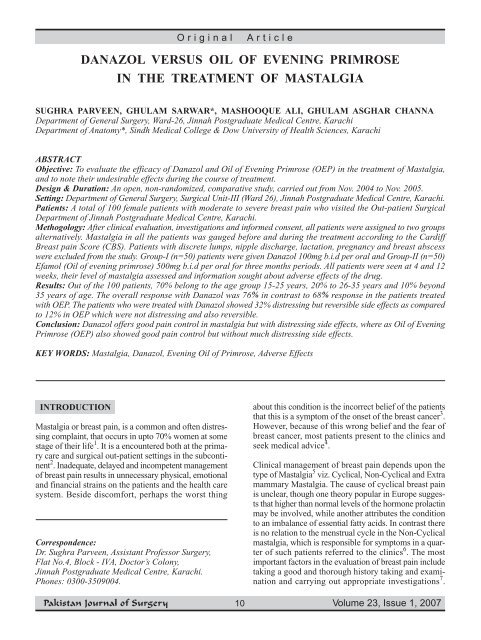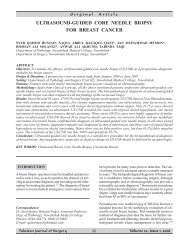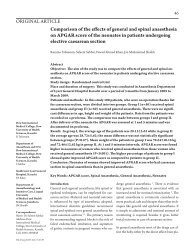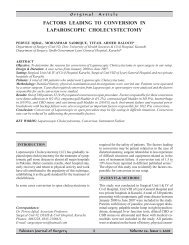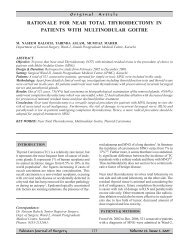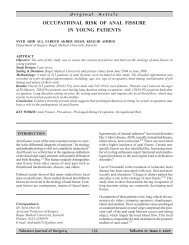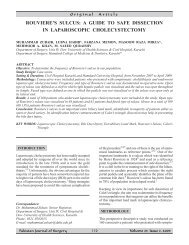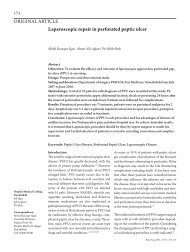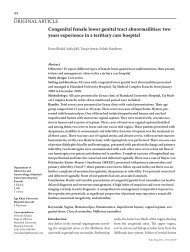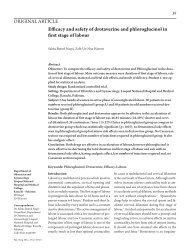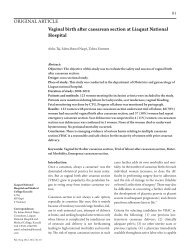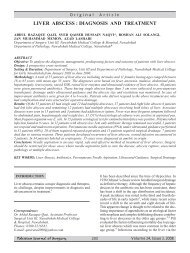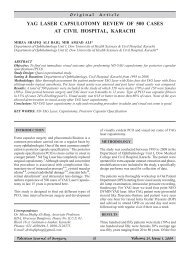danazol versus oil of evening primrose in the treatment of mastalgia
danazol versus oil of evening primrose in the treatment of mastalgia
danazol versus oil of evening primrose in the treatment of mastalgia
You also want an ePaper? Increase the reach of your titles
YUMPU automatically turns print PDFs into web optimized ePapers that Google loves.
Orig<strong>in</strong>al<br />
Article<br />
DANAZOL VERSUS OIL OF EVENING PRIMROSE<br />
IN THE TREATMENT OF MASTALGIA<br />
SUGHRA PARVEEN, GHULAM SARWAR*, MASHOOQUE ALI, GHULAM ASGHAR CHANNA<br />
Department <strong>of</strong> General Surgery, Ward-26, J<strong>in</strong>nah Postgraduate Medical Centre, Karachi<br />
Department <strong>of</strong> Anatomy*, S<strong>in</strong>dh Medical College & Dow University <strong>of</strong> Health Sciences, Karachi<br />
ABSTRACT<br />
Objective: To evaluate <strong>the</strong> efficacy <strong>of</strong> Danazol and Oil <strong>of</strong> Even<strong>in</strong>g Primrose (OEP) <strong>in</strong> <strong>the</strong> <strong>treatment</strong> <strong>of</strong> Mastalgia,<br />
and to note <strong>the</strong>ir undesirable effects dur<strong>in</strong>g <strong>the</strong> course <strong>of</strong> <strong>treatment</strong>.<br />
Design & Duration: An open, non-randomized, comparative study, carried out from Nov. 2004 to Nov. 2005.<br />
Sett<strong>in</strong>g: Department <strong>of</strong> General Surgery, Surgical Unit-III (Ward 26), J<strong>in</strong>nah Postgraduate Medical Centre, Karachi.<br />
Patients: A total <strong>of</strong> 100 female patients with moderate to severe breast pa<strong>in</strong> who visited <strong>the</strong> Out-patient Surgical<br />
Department <strong>of</strong> J<strong>in</strong>nah Postgraduate Medical Centre, Karachi.<br />
Methogology: After cl<strong>in</strong>ical evaluation, <strong>in</strong>vestigations and <strong>in</strong>formed consent, all patients were assigned to two groups<br />
alternatively. Mastalgia <strong>in</strong> all <strong>the</strong> patients was gauged before and dur<strong>in</strong>g <strong>the</strong> <strong>treatment</strong> accord<strong>in</strong>g to <strong>the</strong> Cardiff<br />
Breast pa<strong>in</strong> Score (CBS). Patients with discrete lumps, nipple discharge, lactation, pregnancy and breast abscess<br />
were excluded from <strong>the</strong> study. Group-I (n=50) patients were given Danazol 100mg b.i.d per oral and Group-II (n=50)<br />
Efamol (Oil <strong>of</strong> <strong>even<strong>in</strong>g</strong> <strong>primrose</strong>) 500mg b.i.d per oral for three months periods. All patients were seen at 4 and 12<br />
weeks, <strong>the</strong>ir level <strong>of</strong> <strong>mastalgia</strong> assessed and <strong>in</strong>formation sought about adverse effects <strong>of</strong> <strong>the</strong> drug.<br />
Results: Out <strong>of</strong> <strong>the</strong> 100 patients, 70% belong to <strong>the</strong> age group 15-25 years, 20% to 26-35 years and 10% beyond<br />
35 years <strong>of</strong> age. The overall response with Danazol was 76% <strong>in</strong> contrast to 68% response <strong>in</strong> <strong>the</strong> patients treated<br />
with OEP. The patients who were treated with Danazol showed 32% distress<strong>in</strong>g but reversible side effects as compared<br />
to 12% <strong>in</strong> OEP which were not distress<strong>in</strong>g and also reversible.<br />
Conclusion: Danazol <strong>of</strong>fers good pa<strong>in</strong> control <strong>in</strong> <strong>mastalgia</strong> but with distress<strong>in</strong>g side effects, where as Oil <strong>of</strong> Even<strong>in</strong>g<br />
Primrose (OEP) also showed good pa<strong>in</strong> control but without much distress<strong>in</strong>g side effects.<br />
KEY WORDS: Mastalgia, Danazol, Even<strong>in</strong>g Oil <strong>of</strong> Primrose, Adverse Effects<br />
INTRODUCTION<br />
Mastalgia or breast pa<strong>in</strong>, is a common and <strong>of</strong>ten distress<strong>in</strong>g<br />
compla<strong>in</strong>t, that occurs <strong>in</strong> upto 70% women at some<br />
stage <strong>of</strong> <strong>the</strong>ir life 1 . It is a encountered both at <strong>the</strong> primary<br />
care and surgical out-patient sett<strong>in</strong>gs <strong>in</strong> <strong>the</strong> subcont<strong>in</strong>ent<br />
2 . Inadequate, delayed and <strong>in</strong>competent management<br />
<strong>of</strong> breast pa<strong>in</strong> results <strong>in</strong> unnecessary physical, emotional<br />
and f<strong>in</strong>ancial stra<strong>in</strong>s on <strong>the</strong> patients and <strong>the</strong> health care<br />
system. Beside discomfort, perhaps <strong>the</strong> worst th<strong>in</strong>g<br />
Correspondence:<br />
Dr. Sughra Parveen, Assistant Pr<strong>of</strong>essor Surgery,<br />
Flat No.4, Block - IVA, Doctor’s Colony,<br />
J<strong>in</strong>nah Postgraduate Medical Centre, Karachi.<br />
Phones: 0300-3509004.<br />
about this condition is <strong>the</strong> <strong>in</strong>correct belief <strong>of</strong> <strong>the</strong> patients<br />
that this is a symptom <strong>of</strong> <strong>the</strong> onset <strong>of</strong> <strong>the</strong> breast cancer 3 .<br />
However, because <strong>of</strong> this wrong belief and <strong>the</strong> fear <strong>of</strong><br />
breast cancer, most patients present to <strong>the</strong> cl<strong>in</strong>ics and<br />
seek medical advice 4 .<br />
Cl<strong>in</strong>ical management <strong>of</strong> breast pa<strong>in</strong> depends upon <strong>the</strong><br />
type <strong>of</strong> Mastalgia 5 viz. Cyclical, Non-Cyclical and Extra<br />
mammary Mastalgia. The cause <strong>of</strong> cyclical breast pa<strong>in</strong><br />
is unclear, though one <strong>the</strong>ory popular <strong>in</strong> Europe suggests<br />
that higher than normal levels <strong>of</strong> <strong>the</strong> hormone prolact<strong>in</strong><br />
may be <strong>in</strong>volved, while ano<strong>the</strong>r attributes <strong>the</strong> condition<br />
to an imbalance <strong>of</strong> essential fatty acids. In contrast <strong>the</strong>re<br />
is no relation to <strong>the</strong> menstrual cycle <strong>in</strong> <strong>the</strong> Non-Cyclical<br />
<strong>mastalgia</strong>, which is responsible for symptoms <strong>in</strong> a quarter<br />
<strong>of</strong> such patients referred to <strong>the</strong> cl<strong>in</strong>ics 6 . The most<br />
important factors <strong>in</strong> <strong>the</strong> evaluation <strong>of</strong> breast pa<strong>in</strong> <strong>in</strong>clude<br />
tak<strong>in</strong>g a good and thorough history tak<strong>in</strong>g and exam<strong>in</strong>ation<br />
and carry<strong>in</strong>g out appropriate <strong>in</strong>vestigations 7 .<br />
10<br />
Volume 23, Issue 1, 2007
Danazol Vs. OEP <strong>in</strong> Mastalgia S. Parveen, G.<br />
Score<br />
I<br />
II<br />
III<br />
IV<br />
Excellent response with no residual pa<strong>in</strong><br />
Substantial response but with some<br />
residual pa<strong>in</strong>, considered by <strong>the</strong> patient<br />
to be bearable<br />
Poor response with substantial residual<br />
pa<strong>in</strong><br />
No response at all<br />
Table I. Cardiff Breast pa<strong>in</strong> Score (CBS)<br />
Most (75%-85%) <strong>of</strong> <strong>the</strong> patients generally require no<br />
<strong>treatment</strong> 8 . In <strong>the</strong> rema<strong>in</strong><strong>in</strong>g women pa<strong>in</strong> rema<strong>in</strong> constant<br />
and <strong>in</strong>terfere with <strong>the</strong> day to day activities requir<strong>in</strong>g<br />
some sort <strong>of</strong> <strong>treatment</strong>.<br />
The purpose <strong>of</strong> this study was to compare <strong>the</strong> results<br />
<strong>of</strong> Danazol and Oil <strong>of</strong> Even<strong>in</strong>g Primrose (OEP) <strong>in</strong> respect<br />
to efficacy, rapidity <strong>of</strong> response and adverse effects<br />
<strong>in</strong> <strong>the</strong> <strong>treatment</strong> <strong>of</strong> <strong>mastalgia</strong>.<br />
PATIENTS & METHODS<br />
Response<br />
This study was conducted <strong>in</strong> <strong>the</strong> Out-patient Dept. <strong>of</strong><br />
Surgical Unit III (Ward-26) at J<strong>in</strong>nah Postgraduate<br />
Medical Centre, Karachi from November 2004 to November<br />
2005 on 100 female patients with moderate to<br />
severe breast pa<strong>in</strong>. A thorough history was taken and<br />
a detailed cl<strong>in</strong>ical exam<strong>in</strong>ation was carried out <strong>in</strong> all<br />
<strong>the</strong> patients. Imag<strong>in</strong>g modalities were done where necessary<br />
to rule out benign breast disease and occult carc<strong>in</strong>oma.<br />
After tak<strong>in</strong>g <strong>in</strong>formed consent, all patients were<br />
allocated to <strong>the</strong> two groups, alternatively. All patients<br />
were gauged accord<strong>in</strong>g to Cardiff Breast pa<strong>in</strong> Score<br />
(CBS) as shown <strong>in</strong> Table I. Patients with discrete lumps,<br />
nipple discharge, lactation, pregnancy and breast abscess<br />
were excluded from <strong>the</strong> study.<br />
Side effect<br />
Altered taste<br />
Nausea / vomit<strong>in</strong>g<br />
Abdom<strong>in</strong>al bloat<strong>in</strong>g<br />
Menstrual problem<br />
Weight ga<strong>in</strong><br />
Hirsutism<br />
Group-I (compris<strong>in</strong>g 50 patients) was given Danazol<br />
100mg b.i.d per oral, while Group-II (also compris<strong>in</strong>g<br />
50 patients) was given Efamol (Oil <strong>of</strong> Even<strong>in</strong>g Primrose)<br />
500mg b.i.d per oral for a three months period. Response<br />
<strong>of</strong> <strong>the</strong> <strong>treatment</strong> was gauged accord<strong>in</strong>g to <strong>the</strong> Cardiff<br />
Breast pa<strong>in</strong> Score at 4 weeks and 12 weeks. Information<br />
was also sought about <strong>the</strong> adverse effects <strong>of</strong> <strong>the</strong> drugs.<br />
No change was made <strong>in</strong> <strong>the</strong> <strong>treatment</strong> before three<br />
months. After collect<strong>in</strong>g <strong>the</strong> data, results were compared<br />
and analyzed by <strong>the</strong> student t-test and chi-square test.<br />
RESULTS<br />
Group-I<br />
(Danazol)<br />
Table III. Side effects <strong>of</strong> <strong>the</strong> Drugs<br />
Out <strong>of</strong> <strong>the</strong> 100 patients, 70% belong to <strong>the</strong> age group<br />
15-25 years, 20% to 26-35 years and 10% beyond 35<br />
years <strong>of</strong> age. Fifty two percent women (mean age 28<br />
years) had cyclical <strong>mastalgia</strong> whereas 48% (mean age<br />
34.5 years) had non-cyclical <strong>mastalgia</strong>.<br />
Amongst those patients who used Danazol, Grade-I<br />
response was observed <strong>in</strong> 22 (44%) patients at 4 weeks<br />
and 38 (76%) patients at 12 weeks <strong>in</strong> comparison to<br />
OEP patients with 36% at four and 68% at 12 weeks<br />
(Table II). Adverse effects observed at <strong>the</strong> end <strong>of</strong> <strong>the</strong><br />
<strong>treatment</strong> were 32% <strong>in</strong> Danazol Group which were distress<strong>in</strong>g<br />
but reversible and 12% <strong>in</strong> OEP Group which<br />
were not distress<strong>in</strong>g and reversible (Table III).<br />
--<br />
--<br />
--<br />
6<br />
1<br />
1<br />
Group-II<br />
(OEP)<br />
1<br />
1<br />
1<br />
--<br />
--<br />
--<br />
Table II. Treatment response <strong>in</strong> Mastalgia at 4 weeks and 12 weeks<br />
Grade<br />
Response<br />
Response at 4 weeks<br />
Response at 12 weeks<br />
Gp.I-Danazol Gp.II-OEP Gp.I-Danazol Gp.II-OEP<br />
I<br />
II<br />
III<br />
IV<br />
Excellent<br />
Substantial<br />
Poor<br />
None<br />
22 (44%)<br />
18 (36%)<br />
06 (12%)<br />
04 (08%)<br />
18 (36%)<br />
12 (24%)<br />
12 (24%)<br />
08 (16%)<br />
38 (76%)<br />
06 (12%)<br />
06 (12%)<br />
-- (00%)<br />
34 (68%)<br />
06 (12%)<br />
06 (12%)<br />
04 (08%)<br />
11<br />
Volume 23, Issue 1, 2007
Danazol Vs. OEP <strong>in</strong> Mastalgia S. Parveen, G.<br />
DISCUSSION<br />
Mastalgia is a common and enigmatic condition; it was<br />
described <strong>in</strong> <strong>the</strong> medical literature as early as 1829 9 ,<br />
but was known to medical practitioners much earlier 10 .<br />
Amongst a large cohort <strong>of</strong> 2400 women enrolled <strong>in</strong> a<br />
health ma<strong>in</strong>tenance organization <strong>in</strong> <strong>the</strong> United States<br />
pa<strong>in</strong> was <strong>the</strong> most common breast symptom dur<strong>in</strong>g a<br />
ten years period, promot<strong>in</strong>g medical evaluation and<br />
account<strong>in</strong>g for 47% <strong>of</strong> breast related visits 11 . Similarly<br />
<strong>in</strong> a study <strong>of</strong> 1171 women attend<strong>in</strong>g an Obstetrics and<br />
Gynecology cl<strong>in</strong>ic <strong>in</strong> United States, 69% experience<br />
regular premenstrual breast discomfort 12 .<br />
Currently various <strong>treatment</strong> modes are <strong>in</strong> practice for<br />
<strong>the</strong> management <strong>of</strong> breast pa<strong>in</strong> but most are <strong>in</strong>sufficient.<br />
This study was conducted with <strong>the</strong> aim <strong>of</strong> evaluat<strong>in</strong>g<br />
effectiveness, compliance and adverse effects <strong>of</strong> drugs<br />
<strong>in</strong> female patients treated for breast pa<strong>in</strong>. The two agents<br />
used for comparison <strong>in</strong>cluded Danazol and Even<strong>in</strong>g Oil<br />
<strong>of</strong> Primrose (EOP).<br />
Even<strong>in</strong>g Oil <strong>of</strong> Primrose is extracted from <strong>the</strong> seeds <strong>of</strong><br />
Even<strong>in</strong>g Primrose plant (Oeno<strong>the</strong>ria Bennis) 13 . Even<strong>in</strong>g<br />
<strong>primrose</strong> is a versatile plant and can be found near<br />
streams, mounta<strong>in</strong>s, roadsides and even <strong>in</strong> <strong>the</strong> middle<br />
<strong>of</strong> deserts. It is referred as <strong>even<strong>in</strong>g</strong> <strong>primrose</strong> because<br />
<strong>the</strong> flower blooms <strong>in</strong> <strong>the</strong> <strong>even<strong>in</strong>g</strong>. Its <strong>oil</strong> is thus a natural<br />
product ra<strong>the</strong>r than a drug, which is rich <strong>in</strong> essential<br />
fatty acids like l<strong>in</strong>olenic acid. The body converts l<strong>in</strong>olenic<br />
acid <strong>in</strong>to a hormone like substance prostagland<strong>in</strong><br />
(Pg) especially PgE1 14 , that helps <strong>in</strong> <strong>the</strong> reduction <strong>of</strong><br />
<strong>in</strong>flammatory cells. The product is usually prescribed<br />
<strong>in</strong> a dose <strong>of</strong> 500mg b.i.d per oral 1 , though various <strong>in</strong>ternational<br />
studies have used 2-3 grams daily. The optimal<br />
dose and duration <strong>of</strong> <strong>treatment</strong> with EOP is not known 15 .<br />
The first study <strong>of</strong> EOP was conducted <strong>in</strong> Cardiff Mastalgia<br />
Cl<strong>in</strong>ic by University <strong>of</strong> Wales College <strong>of</strong> Medic<strong>in</strong>e<br />
and published <strong>in</strong> <strong>the</strong> Journal <strong>of</strong> <strong>the</strong> Royal Society<br />
<strong>of</strong> Medic<strong>in</strong>e <strong>in</strong> 1992.<br />
Danazol is a syn<strong>the</strong>tic testosterone which b<strong>in</strong>ds to <strong>the</strong><br />
progesterone and androgen receptors, though <strong>the</strong> precise<br />
mechanism <strong>of</strong> action <strong>in</strong> <strong>the</strong> <strong>treatment</strong> <strong>of</strong> <strong>mastalgia</strong> is<br />
unknown. The ma<strong>in</strong> factors limit<strong>in</strong>g <strong>the</strong> use <strong>of</strong> Danazol<br />
is its spectrum <strong>of</strong> side effects. Majority (59%-92%) <strong>of</strong><br />
women treated with Danazol (200mg orally per day)<br />
<strong>in</strong> controlled cl<strong>in</strong>ical trials gets relief <strong>in</strong> breast pa<strong>in</strong> and<br />
tenderness. In our study <strong>the</strong> results showed Danazol to<br />
be significantly effective (76%) <strong>in</strong> <strong>the</strong> <strong>treatment</strong> <strong>of</strong> <strong>mastalgia</strong><br />
as compared to 68% effectiveness <strong>of</strong> EOP, which<br />
is quite comparable. However, <strong>the</strong> side effects <strong>of</strong> Danazol,<br />
which were 32% <strong>in</strong> comparison to very low side<br />
effects <strong>of</strong> EOP that is 8% limits its usage <strong>in</strong> <strong>the</strong> <strong>treatment</strong><br />
<strong>of</strong> <strong>mastalgia</strong>.<br />
The response rate with Danazol has been reported as<br />
70% <strong>in</strong> cyclical <strong>mastalgia</strong> and 31% <strong>in</strong> non-cyclical <strong>mastalgia</strong>;<br />
although a relapse rate <strong>of</strong> 50% was also reported<br />
<strong>in</strong> <strong>the</strong> same study 16 . Ano<strong>the</strong>r study describes a 79.4%<br />
success rate <strong>in</strong> cyclical and 77.7% for non-cyclical<br />
<strong>mastalgia</strong>, but <strong>the</strong> side effects especially nausea and<br />
irregular menses were frequent (20.6%) with Danazol<br />
<strong>the</strong>rapy 17 .<br />
Qureshi and Sultan 1 showed a cl<strong>in</strong>ical response <strong>of</strong> 64%<br />
with EOP, which is similar to that <strong>of</strong> ours, though o<strong>the</strong>r<br />
studies report a decreased overall response rate <strong>of</strong> 58% 18 .<br />
Shabbir 19 also advocates us<strong>in</strong>g a protocol <strong>of</strong> reassurance,<br />
adherence to low fat methyl xanth<strong>in</strong>e restricted diet and<br />
dietary supplementation with 500mg/day <strong>of</strong> <strong>even<strong>in</strong>g</strong><br />
<strong>primrose</strong> <strong>oil</strong> as <strong>the</strong> first l<strong>in</strong>e <strong>of</strong> <strong>treatment</strong> <strong>in</strong> <strong>mastalgia</strong>.<br />
CONCLUSION<br />
This study has shown that Danazol (Danocr<strong>in</strong>e) <strong>of</strong>fered<br />
good pa<strong>in</strong> control <strong>in</strong> <strong>mastalgia</strong> with distress<strong>in</strong>g side effects<br />
which were reversible, whereas <strong>the</strong> Oil <strong>of</strong> Even<strong>in</strong>g<br />
Primrose also showed good pa<strong>in</strong> control but without<br />
any distress<strong>in</strong>g side effects.<br />
REFERENCES<br />
1. Qureshi S, Sultan N. Topical non-steroidal anti-<strong>in</strong>flammatory<br />
drugs <strong>versus</strong> Oil <strong>of</strong> Even<strong>in</strong>g Primrose<br />
<strong>in</strong> <strong>treatment</strong> <strong>of</strong> Mastalgia. Surgeon 2005; 3: 7-10.<br />
2. Krishnaswamy U. Pr<strong>of</strong>ile <strong>of</strong> Benign Breast disorders<br />
and diseases <strong>in</strong> urban India. Indian J Surg 2003;<br />
65: 178-81.<br />
3. Preece RE, Baumm M, Mansel RE, Webster DJ,<br />
Fortt RW, Gravelle IH, et al. The importance <strong>of</strong><br />
Mastalgia <strong>in</strong> operable Breast cancer. Br Med J 1982;<br />
284: 1299-330.<br />
4. Davies EL, Gateley CA, Miers M, Mansel RE. The<br />
long-term course <strong>of</strong> Mastalgia. J R Soc Med 1988;<br />
91: 462-4.<br />
5. Fentiman IS. Tamoxifen and Mastalgia: An emerg<strong>in</strong>g<br />
<strong>in</strong>dication. Drugs 1986; 32: 477-80.<br />
6. Wisbey JR, Kumar S, Mansel RE, Peece PE, Pye<br />
JK, Hughes LE. The natural history <strong>of</strong> Breast pa<strong>in</strong>.<br />
Lancet 1983; 2: 672-4.<br />
7. Le<strong>in</strong>ster SJ, Whitehouse GH, Walsh PV. Cyclical<br />
Mastalgia: Cl<strong>in</strong>ical and mammographic observation<br />
<strong>in</strong> a screened population. Br J Surg 1987; 74: 220-<br />
222.<br />
12<br />
Volume 23, Issue 1, 2007
Danazol Vs. OEP <strong>in</strong> Mastalgia<br />
8. Belieu RM. Mastodynia. Obstet Gynecol Cl<strong>in</strong> North<br />
Am 1994; 21 (3): 461-77.<br />
9. Grimm K, Firtsche E. Reduction <strong>of</strong> Breasts: Hans<br />
Schaller and first mamoplasty (<strong>in</strong> German). Handichir;<br />
1561.<br />
10. Barton MB, Elmose JG, Fletcher. Breast symptoms<br />
among women enrolled <strong>in</strong> a health ma<strong>in</strong>tenance<br />
organization: Frequency, evaluation and out come.<br />
Ann Interm Med 1999; 130: 651-657.<br />
11. Alder DN, Browne MVV. Prevalence and impact<br />
<strong>of</strong> cyclic <strong>mastalgia</strong> <strong>in</strong> a United States cl<strong>in</strong>ic-based<br />
sample. Am J Obstet Gynaecol 1997; 177: 126-32.<br />
12. Hanif AM, Rasool H, Tariq M, Khan A. Presentation,<br />
management and outcome <strong>of</strong> Mastalgia. J Surg Pak<br />
2005; 10: 15-7.<br />
13. Gately CA, Miers M, Mansel RE, Hughes LE. Drug<br />
<strong>treatment</strong>s for Mastalgia: 17 years experience at<br />
Cardiff Mastalgia Cl<strong>in</strong>ic. J R Soc Med 1992; 85:<br />
12-15.<br />
14. Caleffim IN, Proanel C, Chantary MA, Hayword<br />
JL. Double bl<strong>in</strong>d controlled trail <strong>of</strong> Tamoxifen <strong>the</strong>rapy<br />
for Mastalgia. Lancet 1986; 1: 287-88.<br />
15. Kleijnen J. Even<strong>in</strong>g <strong>primrose</strong> <strong>oil</strong>. Br Med J 1994;<br />
309: 824-25.<br />
16. Gumm R, Cunnick GH, Mokbel K. Evidence for<br />
<strong>the</strong> management <strong>of</strong> Mastalgia. Current Medical Research<br />
and Op<strong>in</strong>ions 2004; 20: 681-684.<br />
17. Ortiz-Mendoza CM, Olvera-Mancilla M. Danazol<br />
effectivity <strong>in</strong> control <strong>of</strong> moderate to severe Mastalgia.<br />
Cir 2004; 72: 479-82.<br />
18. Pye JK, Mansel RE, Hughes LE. Cl<strong>in</strong>ical experience<br />
<strong>of</strong> drug <strong>treatment</strong>s <strong>of</strong> Mastalgia. Lancet 1985; 2:<br />
373-77.<br />
19. Shabbir MN. Dilemma <strong>of</strong> Mastalgia. Pak J Surg<br />
2006; 22: 27-31.<br />
S. Parveen, G<br />
13<br />
Volume 23, Issue 1, 2007


